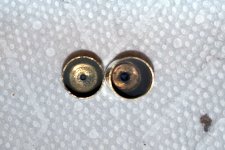throttleup
New member
Interesting Problem -
I'm reloading 9mm's last week for a Saturday match on my Dillon Square Deal press and "Wham!" The handle comes to a dead stop. I check all the stations and nothing appears wrong and again "Wham", dead stop. I suspect that it is the decapping and resizing station. I take out the empty case and move the handle through the remaining stations with no problem.
I examine the empty brass case. It's a Norma brand otherwise appears normal. I try another one, no go, another one no go, a Federal, no problem, Winchester no problem, Blazer, all good. Another Norma, again no go.
Apparently the primer hole in Norma 9mm brass is a bit smaller than all other commercial brands, military too. My decapping pin will not enter the primer hole.
I looked close to make sure it wasn't Berdan primed but it only had the single hole in the middle. A smaller that usual hole. This was brass recovered from an indoor range. I've never used Norma 9mm ammo so I don't know what the box might have read.
Anyone else had this problem? Anyone know the reason?
I'm reloading 9mm's last week for a Saturday match on my Dillon Square Deal press and "Wham!" The handle comes to a dead stop. I check all the stations and nothing appears wrong and again "Wham", dead stop. I suspect that it is the decapping and resizing station. I take out the empty case and move the handle through the remaining stations with no problem.
I examine the empty brass case. It's a Norma brand otherwise appears normal. I try another one, no go, another one no go, a Federal, no problem, Winchester no problem, Blazer, all good. Another Norma, again no go.
Apparently the primer hole in Norma 9mm brass is a bit smaller than all other commercial brands, military too. My decapping pin will not enter the primer hole.
I looked close to make sure it wasn't Berdan primed but it only had the single hole in the middle. A smaller that usual hole. This was brass recovered from an indoor range. I've never used Norma 9mm ammo so I don't know what the box might have read.
Anyone else had this problem? Anyone know the reason?

